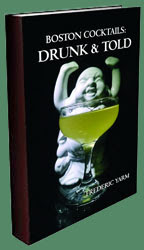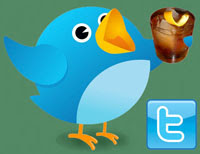 During the Boston Cocktail Summit in October, I met Joseph Carlin, a nutrition and food history professor at UMASS Boston who wrote Cocktails: A Global History
During the Boston Cocktail Summit in October, I met Joseph Carlin, a nutrition and food history professor at UMASS Boston who wrote Cocktails: A Global HistoryCocktails: A Global History does not try to take the history of cocktails and spirits to the same depth of say David Wondrich's Imbibe! or William Grime's Straight Up or On the Rocks. However, it would make a great first overview from the scientific breakthroughs in distillation to the globalization of the cocktail. Moreover, the social aspects of the cocktail covered here reminded me of the RISD museums's 2011 "Cocktail Culture" exhibition with a focus on the tools, cocktail dresses, traditions, and symbolism involved in drinking culture. Despite some simplification of details or taking some hypothesis as fact, the book does a good job of covering a wide swath of history in a short format.
Even with my description of it being an overview, I was still gleaning bits of trivia and learning aspects of cocktails that I was unaware of or had forgotten. In the chapter on punch, for example, Carlin describes how it was common in making a bowl of punch to finish with draping a long curlicue of citrus peel over the edge of a punch bowl to signify that it was freshly made; many Dutch still-life painters captured this in their art. Carlin suggests that this tradition may explain why citrus twists, slices, and wedges are still popular garnishes today. Furthermore, in the tavern chapter, the etymology of bar was proposed. Back in the colonial tavern, the area where the spirits and punch bowls were stored and the drinks were made was locked up in the off hours with bars and slats which extended from counter top to ceiling and were raised when the drink making time began.
The book is not too much of a cocktail recipe collection but is instead an overview of the various classes of drinks and their ingredients. This also includes the wide assortment of food and drink that acquired the name cocktail such as fruit and shrimp. The most curious cocktail contained within is the 19th century libation, the Brompton Cocktail. Created at a London hospital, it contained gin, honey, and morphine for the very sick; in fact, it often got dubbed by the staff as the Terminal Cocktail. Even some of today's medications, such as AIDS anti-retroviral drug combinations, are still called cocktails.
Overall, Cocktails: A Global History
 The 2017 collection of 855 drink recipes, bartender tributes, and essays on hospitality from CocktailVirgin's Frederic Yarm. Available at
The 2017 collection of 855 drink recipes, bartender tributes, and essays on hospitality from CocktailVirgin's Frederic Yarm. Available at  The 2012 collection of 505 drink recipes, techniques, and Boston bar recommendations from Frederic Yarm. Available at
The 2012 collection of 505 drink recipes, techniques, and Boston bar recommendations from Frederic Yarm. Available at 




2 comments:
I own and have read Whiskey: A Global History, which is a part of this series and is written by fellow DC blogger Kevin Kosar.
I would describe the tone of the book in almost exactly the same way that you did for this book: a light and easy primer that spans the histories of different disciplines, interspersed with great facts to remember. It's nice to see that there's a common intonation that the book series maintains.
When I researched the publisher, the series goes beyond booze to a whole edible series. And it extends beyond edible to other topics as well.
Post a Comment